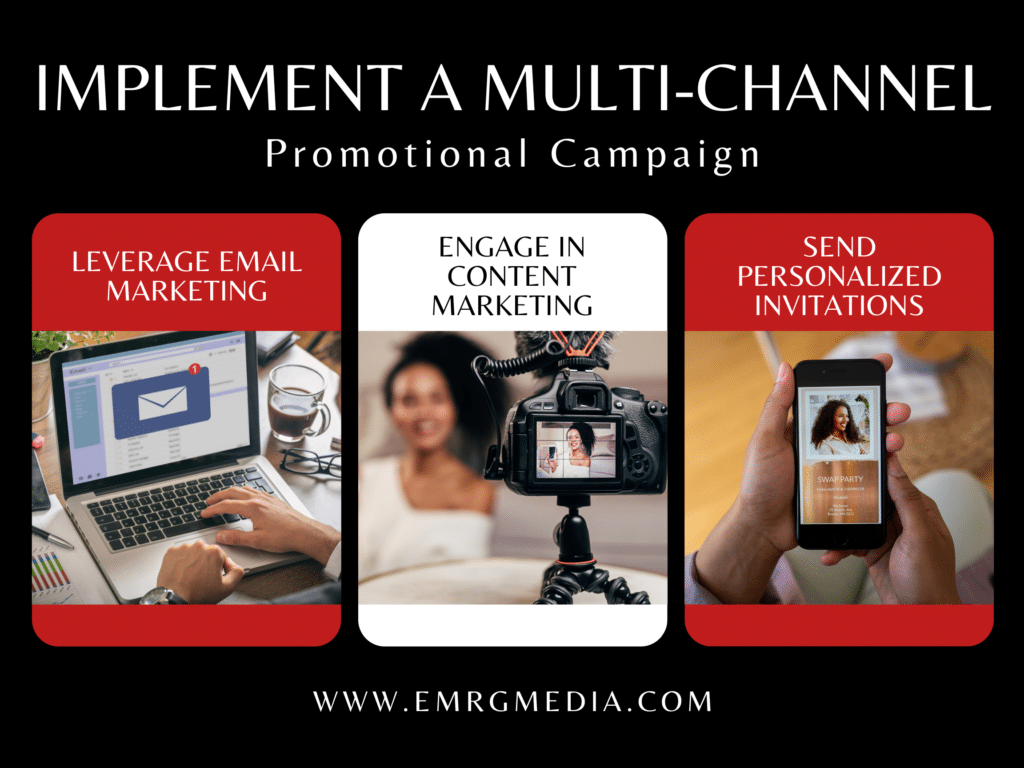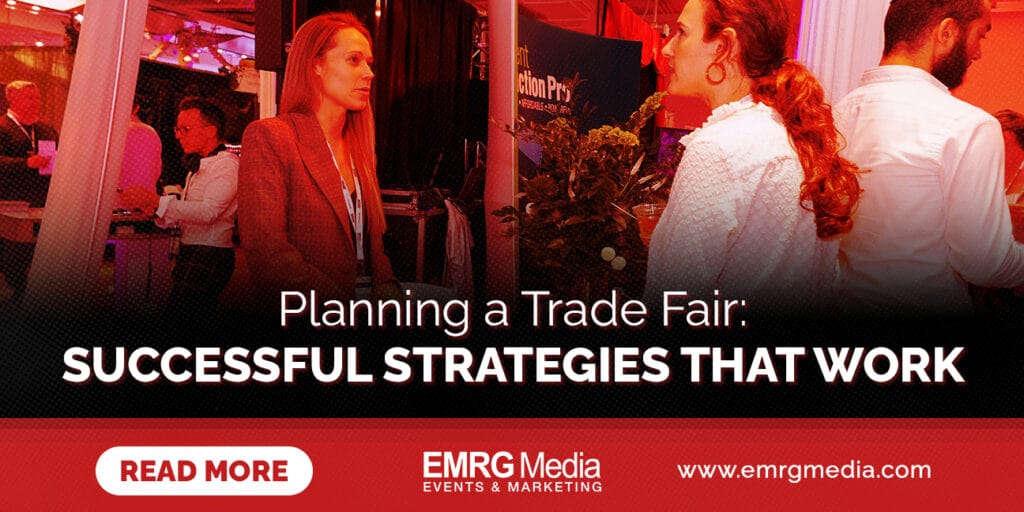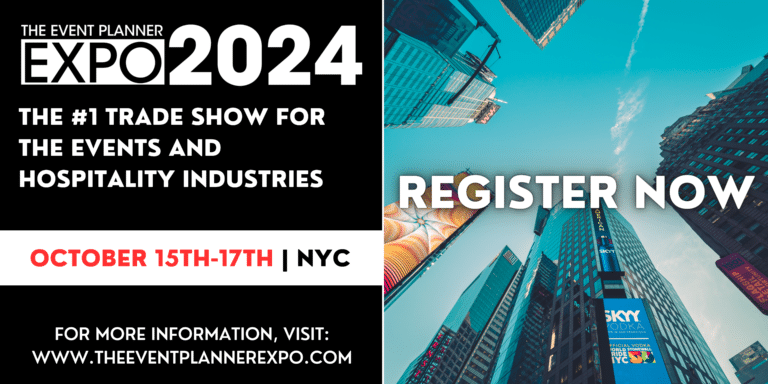Trade fairs are a game-changer for businesses looking to showcase their products, connect with potential customers, and make a splash in their industry. But let’s be honest – planning a trade fair can feel daunting. Where do you even begin?
I have definitely been down that road; the struggle is real! But after years of experience and a few trade fair triumphs, I’ve learned that with the right strategies and a solid plan, you can turn your trade fair dreams into a reality.
Whether you’re entering/planning a trade fair for the first time or have years of experience, let me guide you through crafting an unforgettable event that will make waves among competitors. Get ready to take some notes and transform your trade fair game!
Ready to turn your event vision into a reality? Contact EMRG Media and let our team of experts guide you through a seamless and unforgettable event planning experience in New York City.
Table Of Contents:
- Develop a Comprehensive Strategy in Planning a Trade Fair
- Design an Eye-Catching Trade Show Booth
- Implement a Multi-Channel Promotional Campaign
- Prepare Your Trade Show Staff
- Evaluate and Measure Trade Show Success
- FAQs in Relation to Planning a Trade Fair
- Strategic Insights: Planning a Trade Fair for Success
Develop a Comprehensive Strategy in Planning a Trade Fair
Trade shows require meticulous planning, and one of the key steps is defining your target audience. Whether it’s industry leaders, small business owners, or event tech enthusiasts, they are the ones who shape your strategy.
Tailoring your approach to them is not just important, it’s crucial for the success of your trade show. It’s a clear reflection of their significance in the trade show world.
Set SMART Goals
Setting goals for your trade show is not just important, it’s vital. These goals must be SMART: Specific, Measurable, Achievable, Relevant, and Time-bound. This approach is your compass, keeping you on track.
Whether it’s about getting 100 leads or 10 immediate sales, having clear and SMART objectives helps you stay focused and motivated, and it makes measuring success a breeze.
Create a Marketing Plan
Now that you know your target audience and goals, creating a killer marketing strategy is time. Use email campaigns, social media, and targeted ads to promote your presence before and during the event.
Don’t forget the post-show follow-up to keep the momentum going.
Having a solid marketing plan is essential for trade show success. It’s not just about the few days of the event – you need a comprehensive strategy that covers before, during, and after the show. #EventMarketing #TradeShows
— John Smith (@JohnSmithEvents) March 1, 2023
Money matters! Plan your budget carefully for a successful trade show. Include booth rental, exhibit design, staffing, materials, and travel expenses.
Set a realistic budget and prioritize wisely based on what will impact your success the most. Don’t overspend on a flashy booth and neglect marketing.
Assemble Your Trade Show Team
Your trade show team is crucial. Pick people with different skills—sales, marketing, technical know-how, and excellent people skills. Train them well on goals, plans, and messaging.
This inclusive approach builds teamwork and sets you up for success at any trade show.
Design an Eye-Catching Trade Show Booth
Embark on a journey of booth design creativity! Your trade show booth is a platform for you to shine. It’s not just about aesthetics; it’s about crafting an immersive experience that captivates your audience and aligns with your objectives.
Size, layout, and functionality are vital considerations. Strategically map out your exhibit space for product demos, meetings, and interactive displays. A meticulously designed booth effortlessly steers attendees through your brand narrative.
For instance, showcases how a well-designed booth can effectively communicate a brand’s story.
Incorporate Your Brand Elements
Your brand is your identity, and it’s crucial to reflect it in your booth design. From logo placement to color schemes, ensure consistency with your brand image. Incorporate key messages creatively and avoid mere logo placement.
Think innovatively to make your brand stand out. Create a unified, memorable brand experience that lingers with attendees post-event, reinforcing the significance of your brand in their minds.
Utilize Engaging Visuals
Visuals matter! Aim for eye-catching displays that convey your message instantly. Use bold graphics, high-quality images, and videos to showcase your products.
Engage attendees by using touch screens or VR demos. The goal is to grab attention and spark meaningful interactions with potential clients.
“The best trade show booths are the ones that tell a story. They use visuals, messaging, and interactive elements to create an immersive experience that draws attendees in and leaves a lasting impression.” – Sarah Johnson, Event Marketing Consultant
Your booth is more than a product display; it’s an atmosphere. Consider the mood you want to set: high-tech, cozy, or playful. Design a welcoming space with comfortable seating, good lighting, and thoughtful extras like refreshments.
Create an environment where attendees feel drawn to spend time reflecting positively on your brand.
Optimize Your Booth Location
Location is a game-changer! Aim for a booth spot that is easily visible and close to high-traffic areas like entrances or main stages. Be aware of your neighbors; exposure is beneficial, but competitors nearby could present challenges.
Visit the venue early to scout locations and negotiate with organizers for a prime spot. It could significantly influence your success.
Implement a Multi-Channel Promotional Campaign
It’s time to ignite the buzz! A well-executed multi-channel promotional campaign is the key to not just drawing attendees to your booth, but to a successful trade show experience.
By using various marketing channels, you can generate excitement and provide visitors with irresistible reasons to visit your stand, instilling a sense of confidence and motivation in your team.
Leverage Email Marketing
Email, a potent marketing tool for trade show promotion, becomes even more powerful when you personalize it. By segmenting your list and tailoring messages to each group’s interests, you make your audience feel valued and important.
Include booth details, special events, and a clear call to action, and craft a compelling subject line to entice recipients to open your email.
It’s true; shooting off an email remains a top-notch way to get eyeballs on your upcoming events. Segment your list, personalize your messaging, and give recipients a reason to visit your booth. #EmailMarketing #TradeShows
— Sarah Johnson (@SarahJohnsonEM) March 3, 2023

Harness the power of social media for your trade show promotion. Plan posts leading up to the event, mixing up content types and using event hashtags. Tag organizers and influencers, and consider running contests to boost engagement and drive booth traffic.
Engage in Content Marketing
Content marketing is not just a strategy, it’s your exhibit’s superpower. By crafting valuable content like blog posts, whitepapers, or videos that align with the trade show’s theme, you can inspire and excite your audience.
Promote this content through email and social media to drive traffic to your website and booth. Establish thought leadership and stand out from competitors with unique insights.
Early bird deals add excitement; discounts or special promotions entice attendees. Promote offers clearly through email and social media, and track and fulfill promotions on-site.
Send Personalized Invitations
Don’t underestimate the power of personalized invitations. Reaching out directly to prospects, customers, or influencers, and highlighting what they’ll gain from visiting your booth can make a significant difference.
Tailor each invitation to the recipient, emphasizing the value for them. Send via email, direct mail, or personalized social media messages. Show appreciation and offer something irresistible to reel them in.
Key Takeaway: Stand out at trade shows by crafting a clear strategy: Know your audience, set SMART goals, market like a pro before and after the event, budget wisely, build an amazing team and booth. Use visuals that pop and create an inviting space to draw people in.
Prepare Your Trade Show Staff
Your trade show staff represents your company. They engage attendees, answer questions, and drive leads. Invest time in preparing them for success with these key areas:
Train Your Staff on Booth Etiquette
First impressions matter, especially at a busy trade show where you have mere seconds to capture someone’s attention. Training your staff on proper booth etiquette can make all the difference in how attendees perceive your brand.
Some key points to cover in your staff training:
- Greeting attendees with a smile and friendly demeanor.
- Maintaining professional dress and appearance.
- Avoiding eating, drinking, or using phones in the booth.
- Engaging attendees in conversation, not just sales pitches.
Role-playing exercises can be a great way to practice these skills and build confidence before the big event.
Assign Specific Roles and Responsibilities
At a trade show, every staff member should clearly understand their role and responsibilities. This helps ensure smooth operations and prevents essential tasks from falling through the cracks.
Consider assigning roles such as:
- Greeters to welcome attendees and qualify leads.
- Product experts to give demos and answer technical questions.
- Lead capture specialists to collect contact info and take notes.
- Runners to restock supplies and materials as needed.
A detailed staffing schedule is essential, covering shifts, breaks, and duties for each team member to ensure smooth coverage. Product knowledge is crucial; schedule practice sessions for staff to master demos and anticipate questions.
Hands-on practice boosts confidence and effectiveness when engaging with attendees.
Encourage Teamwork and Collaboration
Foster a supportive team environment to maintain high energy and morale at trade shows. Encourage teamwork, celebrate successes, and debrief daily to share insights and make adjustments.
“Teamwork is the ability to work together toward a common vision. The ability to direct individual accomplishments toward organizational objectives. It is the fuel that allows common people to attain uncommon results.” – Andrew Carnegie
By training your staff, assigning clear roles, practicing demos, and fostering collaboration, you’ll set your team up for trade show success. A well-prepared, cohesive staff is your greatest asset on the show floor.
Evaluate and Measure Trade Show Success
The trade show is over, but don’t rush ahead just yet. Take a moment to review how it went. Knowing what worked and what didn’t helps you plan better for next time.
Set Key Performance Indicators (KPIs)
Start by defining what success means for you at the trade show. Was it about brand awareness, generating leads, or boosting sales? Once you know your goals, pick the metrics (like these) that show if you’ve hit them:
- Number of leads captured.
- Quality of leads (based on qualifying criteria).
- Number of sales or revenue generated.
- Number of product demos or trials given.
- Social media mentions or engagement.
- Website traffic or page views (especially to your trade show landing page).
Clear KPIs give you a yardstick to measure your results. They show whether your trade show investment was worth it and where you can improve.
Gather Attendee Feedback
Your booth staff saw everything up close. Their input is gold for reviewing and planning. Here are some questions to get their insights:
- What questions or concerns did attendees have about our products/services?
- What were the most common objections or hesitations you heard?
- What did attendees seem most excited or interested in?
- How did our booth and staff compare to other exhibitors?
- What could we do differently or better next time?
Besides your staff, hear from the attendees directly. Send a survey to the leads you got after the show. Ask them how they felt about your booth and your brand.
Here are some questions to include:
- How satisfied were you with your experience at our booth?
- Did you find the information or demos helpful and relevant?
- How likely are you to consider our products/services in the future?
- What could we do to improve your experience next time?
Attendee feedback can help you understand how well you met their needs and expectations and identify gaps or pain points in your approach.
Analyze Lead Quality and Quantity
Lead quantity matters, but so does quality. Look closely at the leads you got:”
- How many were “hot” leads ready to buy vs. “warm” or “cold” leads?
- How well did they fit your target customer profile or buyer persona?
- How engaged were they in your booth conversations and follow-ups?
Quantity isn’t everything. If you have lots of leads but they’re less likely to buy, rethink your strategy. Adjust your questions, audience targeting, or booth activities.
But if you have fewer high-quality leads, you’re doing well. Concentrate on nurturing those relationships.
Calculate Return on Investment (ROI)
Trade shows can cost a lot, including booth space, travel, and promotions. To see if it’s worth it, find your ROI. ROI shows if you made a profit or loss from your investment.
Use this formula to calculate ROI for a trade show:
ROI = (Gross Profit from Show – Total Show Investment) / Total Show Investment
For example, let’s say your total trade show investment was $20,000, and you generated $50,000 in gross profit from the leads and sales attributed to the show. Your ROI would be:
($50,000 – $20,000) / $20,000 = 1.5 or 150%
An ROI of 150% means that if you invested $1 in the trade show, you got $1.50 back. Usually, an ROI of 100% or more is seen as good. Remember, some benefits like brand recognition or networking are tricky to measure in money.
Still, calculating ROI helps gauge the financial impact of your trade show.
Apply Insights to Future Trade Shows
The insights you gain from evaluating your trade show performance are only valuable if you use them to inform and improve your future efforts. Some questions to consider as you review your results:
- What goals did we achieve or exceed? What contributed to that success?
- Where did we fall short of our goals? What factors may have hindered us?
- What feedback or trends emerged from attendee and staff input?
- Based on our ROI, was this trade show a worthwhile investment? Should we exhibit again next year?
- What changes could we make to our strategy, booth, staff, or follow-up to improve results?
Use your answers to these questions to plan your next trade show: rethink booth design, train staff on lead qualification, or invest in lead nurturing. Treat trade show evaluation as continuous improvement, not just a one-time review.
Regularly assess and apply lessons learned to optimize your strategy and get better results.
“Without continual growth and progress, such words as improvement, achievement, and success have no meaning.” – Benjamin Franklin
Measuring trade show success is crucial yet often neglected. Set clear goals, collect feedback, analyze leads and ROI, and then apply insights to make smarter decisions and achieve better results.
Key Takeaway: Train staff on booth etiquette and product knowledge and assign clear roles for smooth operations. Capture leads efficiently and follow up promptly. Measure success with numbers and feedback to enhance future shows.
FAQs in Relation to Planning a Trade Fair
How do you plan a trade fair?
Dig into your goals, know your audience, and carve out a budget. Then, lock down the venue and vendors early.
How can we make a trade fair?
Gather a team, set clear objectives, and choose the right spot. Promotion is vital—blast it on all channels.
What is trade fair and how is it organized?
A gathering to showcase products to potential buyers is orchestrated with meticulous planning, from layout design to marketing blitzes.
What do you need to prepare for a trade show?
Pack an engaging booth setup, train your crew well, and have product demos ready. Remember lead capture tools.
Strategic Insights: Planning a Trade Fair for Success
Planning a trade fair is no walk in the park. Still, with the right mindset and strategies, you can create an unforgettable experience that showcases your brand and drives actual results.
Remember, it’s all about setting clear goals, designing an eye-catching booth, leveraging multi-channel promotions, preparing your team, and maximizing lead generation and follow-up. Oh, and remember to have a little fun!
So, take these tips, make them your own, and get ready to plan a trade fair that’ll have your competitors green with envy. You’ve got this!
Ready to turn your event vision into a reality? Contact EMRG Media and let our team of experts guide you through a seamless and unforgettable event planning experience in New York City.


.png)
